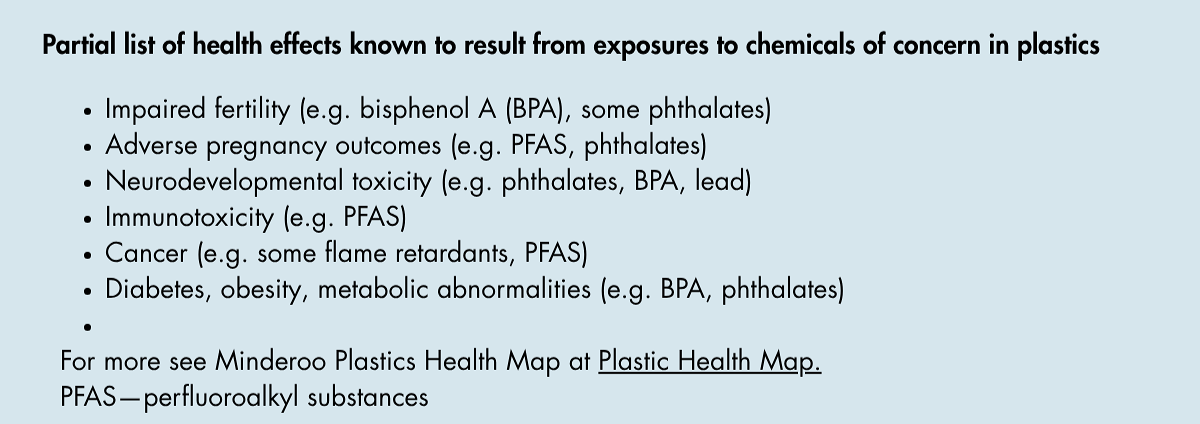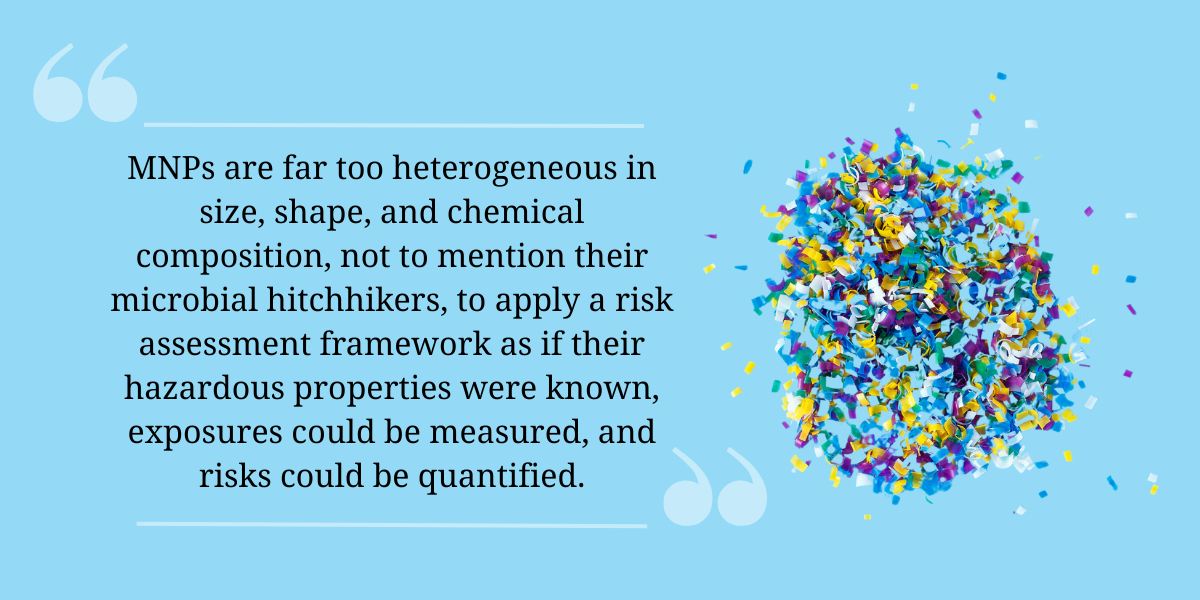Microplastics in the Plasticene: Creating Our Own Diseases
by Ted Schettler, SEHN science director
Plasticene, n. & adj. an era in Earth's history, within the Anthropocene, commencing in the 1950s, marked stratigraphically in the depositional record by a new and increasing layer of plastic (from A Plasticene Lexicon).
“It is seldom recognized that each type of society has diseases peculiar to itself—indeed, that each civilization creates its own diseases.” (René Dubos: The Dreams of Reason: Science and Utopias, 1961)
The origin of the term plasticene as an era in earth’s history is uncertain, although there’s general agreement that it began in the 1950s when plastic production dramatically accelerated. The term became more firmly established in the English lexicon over the decades that followed, with exponential increases in production—and pollution. City streets, streams, rivers, ocean gyres, and beaches strewn with plastic debris became common throughout the world. Less visibly, tiny fragments of plastic, containing biologically active chemicals that plants and animals cannot avoid, also contaminate all of earth’s ecosystems. They are in soil, sediments, air, food, and water—everywhere and in everyone. Like tiny time-release granules in pharmaceuticals, these microplastics leach chemicals that can cause obesity, diabetes, cardiovascular disease, reproductive and development disorders, cancer, and more. Studies documenting microplastic exposures and health effects reveal a complex mixture of problems that will grow rapidly along with plastic production, which is expected to double or triple from current levels by 2050. The impacts of the Plasticene will continue for a very long time.
The complexity of micro- and nanoplastics (MNPs)
Microplastics are tiny plastic particles less than five millimeters in size, while nanoplastics are a smaller subset, at less than one-thousandth of a millimeter. These MNPs largely come from the chemical and mechanical breakdown of products such as food packaging, synthetic fabrics, paint, tires, and others. Some personal care products contain intentionally added MNPs, although pressure is increasing to discontinue those uses.
Plastic products are made from polymers with differing chemical composition to which manufacturers add combinations of other chemicals that impart certain features and functions. The list of potential plastic additives is estimated at over 15,000 individual chemicals, most of which have not been studied for their toxic properties. Those that have been studied can have strikingly diverse health effects, often after even low level exposures. In addition to chemicals intentionally added to a plastic polymer, MNPs pick up additional chemicals from the ambient environment, which they carry into plants and animals that encounter them. Biofilms that form on MNPs in the environment introduce a microbial component to the diverse exposures, adding to the complexity.
Human exposures are well documented. Inhaled, ingested, and potentially absorbed through the skin, MNPs contaminate human blood, urine, feces, breast milk, and semen. Human brains, hearts, blood vessels, livers, kidneys, intestines, bones, testicles, lungs, and placentas are flecked with MNPs. These tiny geometrically, chemically, and biologically diverse fragments are truly a complex mixture of environmental hazards, presenting stunningly difficult research challenges.
The National Academy of Sciences recently concluded a four-part webinar series addressing what we know and would like to know about MNPs and their impacts. Among the research challenges identified:
Collecting, identifying, and quantifying MNPs in environmental samples or in biologic tissues and fluids such as blood are extremely challenging. With no standardized protocols, different methods give different results, making it difficult to compare findings among studies.
Many experimental studies use manufactured MNPs that can yield valuable insights into their health effects. But since these MNPs are unlike the complex mixture of geometrically, chemically, and biologically diverse fragments encountered in the real-world, many effects are likely to be missed.
Nanoplastics are particularly challenging to study because of their small size, and yet they probably have more marked effects than microplastics after exposure since they can be more readily absorbed and penetrate tissue barriers.
Since exposures are difficult to quantify, little is known about dose-response relationships. How much, or little, of this complex physical and chemical mixture is sufficient to elicit an adverse health outcome? How would we know?
Health effects of MNPs
The clearance of MNPs from tissues is exceedingly slow, if it occurs at all. Where present, they can cause oxidative stress, inflammation, immune system and metabolic disruption, decreased cell viability, and fibrosis.
Laboratory animal and human studies show a high likelihood that MNP exposures increase risks of lung inflammation and fibrosis, impaired sperm quality, gastrointestinal disorders including colon cancer, heart attacks and strokes. (See related piece in the January 2025 edition of the Networker.) Many of the animal studies do not account for the various chemical additives in MNPs that can also be harmful.
See the box for a partial list of known health effects from chemical additives present in plastics.
The likelihood of substantial harm; ongoing uncertainties
Many scientists and policy makers are devoted to a risk assessment-risk management framework in which the likelihood of harm resulting from a particular environmental exposure is evaluated using a standardized protocol, followed by options for managing the risk. But this approach is entirely inadequate for MNPs, and scientists studying them know it. MNPs are far too heterogeneous in size, shape, and chemical composition, not to mention their microbial hitchhikers, to apply a risk assessment framework as if their hazardous properties were known, exposures could be measured, and risks could be quantified. It’s an ever-changing complex mixture problem riddled with fundamental uncertainties, both about exposures and outcomes.
These uncertainties can be reduced, but cannot be resolved by doing more research and gathering more data, as important as that is. We have missed the opportunity to take a truly precautionary approach. Widespread contamination and exposures have already occurred and continue to increase. Many scientists and public health professionals nonetheless recognize the need to act now, based on what we already know, despite uncertainties, to keep the harms from increasing.
Managing MNP risks
In the January, 2025 Networker I summarized some of the efforts undertaken internationally and nationally, in states and cities, and in a few economic sectors to address the growing problem of plastic pollution. The United Nations’ project hoping to negotiate a binding treaty failed to come to an agreement in the final scheduled meeting held in South Korea in late 2024. Another meeting will convene in August, 2025 in Geneva, Switzerland. A major point of disagreement remains between high ambition countries wanting a curb on plastic production and low ambition countries wanting to focus on improved recycling without production limits. Currently, only about five to six percent of plastic is recycled in the United States, and about nine percent globally. Recycling can help but is manifestly an insufficient response. Moreover, it is worth noting that mechanical recycling and various waste disposal practices add more MNPs to the environment.
A panel at the recent National Academy workshop discussed mitigation strategies, including:
efforts in the European Union to set tire wear abrasion limits intended to reduce a major source of MNPs;
additional bans on microbeads intentionally added to personal care products;
the importance of redesign of polymers and simplification of additives to enable product reuse, more successful recycling, and reduced toxicity;
additional efforts to reduce single use plastics;
the importance of designing strategies for measuring the impacts of policies intended to reduce MNPs and plastic pollution: what works? what doesn’t?
Beware of greenwashing
Growing concerns about increasing plastic pollution and its impacts have incentivized chemical engineers and product manufacturers to search for new materials and marketing tools. While there have been significant advances in polymer design, misleading product labeling has also crept into the marketplace, confusing customers wanting to make more environmentally and health conscious choices.
Bioplastics: One approach uses plant-based materials, like sugarcane or corn, rather than fossil fuels, as feedstock to make so-called bioplastics. Examples are polylactic acid (PLA) and polyhydroxyalkanoates (PHA). The term simply means that the product is made fully or in part from renewable feedstocks. It should not be interpreted to imply biodegradability or lack of toxicity wherever it is used. Bioplastics can be, but are not necessarily, biodegradable. Some bioplastics do not biodegrade at all. And they can be as toxic as fossil-fuel based plastics, depending on their chemical composition, including additives.
Biodegradable: A truly biodegradable plastic can, under the right conditions, be broken down and decomposed by microorganisms into simpler substances like carbon dioxide, water, inorganic minerals. and biomass that can be reintegrated into the natural environment. Sometimes the term is interpreted to mean that the product will naturally breakdown and recycle into the natural environment regardless of how it is discarded, but this is rarely true. Biodegradation, which can take many years, is highly dependent on environmental conditions, including presence or absence of oxygen, temperature and humidity. Moreover, some plastic products labelled as biodegradable may simply fragment into microplastics over long periods of time rather than completely decomposing. For this reason, the European Union and the State of California sharply restrict use of the term on labels. Harmonization of labeling requirements across more states would help reduce misuse of the term and greenwashing.
Compostable: The American ASTM D6400 compostability standard is the most widely used specification in the United States to support claims that a plastic product is compostable. It certifies that a product can disintegrate in less than 12 weeks, biodegrade within 180 days in an aerobic commercial composting facility, support plant growth, and meet specific limits on heavy metal content.
“Each civilization creates its own diseases” (René Dubos)
Undeniably, the material economy has radically changed with the rapidly accelerating introduction of plastic products into all aspects of daily life since the 1950s. (See Rebecca Altman’s essay in the January 2025 Networker.) Choices among thousands of additives have improved the functional performance of plastic polymers for an array of applications. Development of single-use plastic products meant that markets would continue to grow. Concerns about waste were brushed off with disingenuous and unproven promises of recycling.
Now tiny fragments of plastics and their chemical additives are in everyplace and everyone. While the public health impacts of these complex exposures will never be known with certainty, research into their health effects and trends of the incidence and prevalence of various diseases and disorders such as obesity, diabetes, metabolic abnormalities, reproductive and neurodevelopmental problems, and early onset colon and breast cancers strongly support the plausibility that MNPs are contributing. To be sure, the origins of these disorders are often multifactorial but population-level patterns support Rene Dubos’ observation that “each civilization creates its own diseases.” This civilization has added plastics and MNPs to the mix of factors shaping the health and illnesses of our time.
The potential benefits of removing toxic chemicals from plastics are undeniable. This could be accomplished in some cases by substituting safer alternatives that provide a similar function, but otherwise would require more fundamental product re-design. But beyond problems with toxic chemical additives, few plastic polymers are truly biodegradable. MNPs will continue to accumulate in the environment—more rapidly if plastic production increases as projected.
Extended producer responsibility (EPR) policies requiring product manufacturers to be responsible for products at their end of useful life can help. They are proven to reduce plastic waste, improve recycling rates, and stimulate product re-design. Producers often resist adoption of EPR policies, feeling forced into considering product re-design, increased costs, and threats to current business models. Common products subject to EPR are packaging, electronics, batteries, paint, pharmaceuticals, and textiles. Five states in the U.S. have adopted EPR policies addressing packaging.
We cannot, however, rely on improved recycling to address the scope and scale of plastic pollution. A reduction in plastic production is essential. Non-essential single-use plastic products should urgently be discontinued as a first step. We await the results of the United Nations meeting in Geneva in August to see if the international community can finalize their deliberations. Then we will know if we are collectively prepared to meet this civilizational challenge or if petrostate special interests will prevail, stand in the way, and deliver the consequences.



